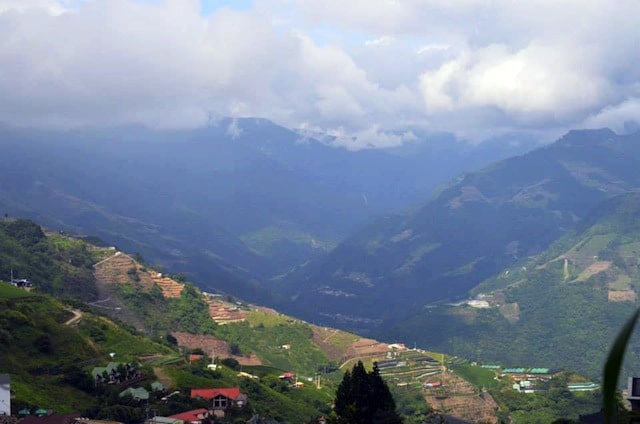
“Have a seat,” Katie says, smiling in her flower-patterned apron. She invites the group into the traditional tea shop, Fungcha Tea Store. “You can sample the highest quality tea in Taiwan.”
Located right outside the Taroko National Park in Taiwan’s Cingjing in Nantou County, the shop sells the highest quality tea in Taiwan. Looking out from the tea shop you’re covered in cloud forest as you take in aerial views of the deep cut valleys and rugged peaks. This altitude from which the leaves are picked are what give them their high quality.
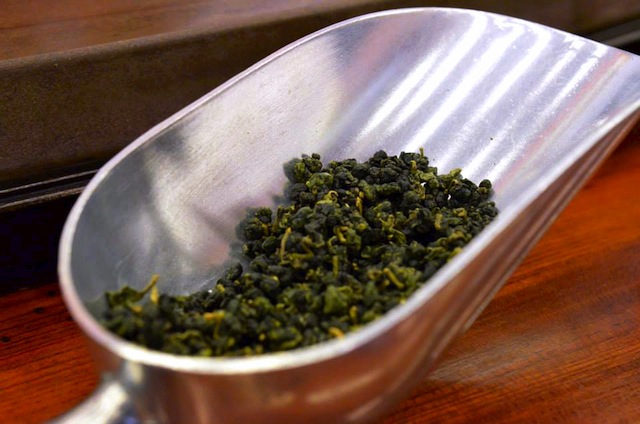
The teas are Oolongs — a traditional Chinese tea — which have leaves with long curled ends or are curled into small balls. Nantou County is the birthplace of tea in Taiwan, with its tea history dating back to 1717 with Oolongs. Oolong teas are rich in antioxidants, and are known for providing tea drinkers with a number of health benefits like reduced cholesterol levels, a strong immune system and heart health.
My friends and I sit at the tea bar, where Katie has six small cups paired with small porcelain cylinders in a row. On the side, a clump of fresh and fragrant vibrant green Oolong tea leafs sit ready to be prepared. Inhaling the fragrance, they smell just like a lush flower garden.
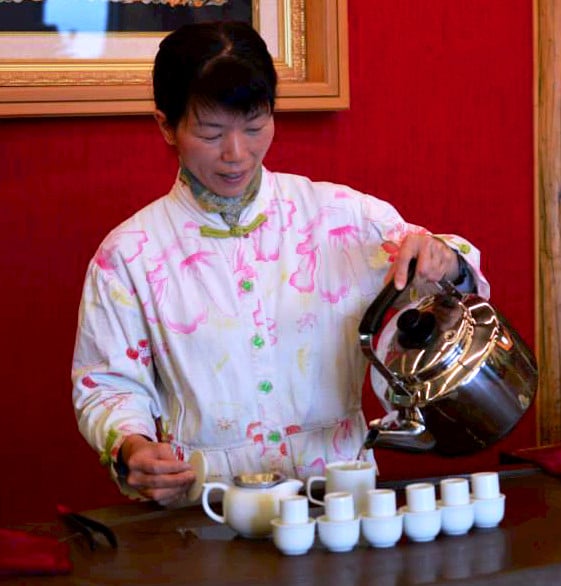
Katie has invited our group to sample a couple of the shop’s teas, each offering coming from a different mountain at a different altitude. What all the teas have in common is thy’re from high altitudes — called High Mountain Teas or Alpine Oolongs — meaning they are grown at 1,000 meters (3,280 feet) or more and enjoy a nice thick cloud cover. Because the sun beating down on the tea leaves is what makes them have a bitter taste, the High Mountain Teas are much sweeter and floral tasting and are considered to be the best quality in Taiwan, especially as the leaves are picked by hand by women known as tea ladies. These tea ladies wear small blades on their thumbs in order to cut the best leaves off the tea trees.
The first tea the group is sampling is a Chi Lai Mountain Oolong, where the leafs grow at around 1,600 to 2,400 meters (5,250 feet to 7,874 feet). We watch in astonishment as Katie performs a ritual that is as complicated and beautiful as a ballet. It is known as cha-yi, or tea art, and focuses on savoring the flavors and fragrances of the tea, appreciating the beauty of the process and relishing in the memories brought forward as the tea interacts with the senses.
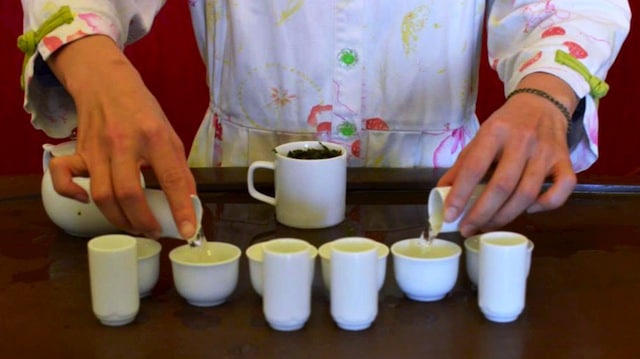
Katie begins by boiling water for five minutes, then steeping the tea leaves for five minutes. From there, she warms the white porcelain cups with hot water before daintily pouring the liquid out onto the table to form a crystalline puddle. The highlight of the show is the final step, when Katie transfers the tea into the small cylinder, gently places the tea cup upside on top of it and then gracefully flips the formation over so the tea is held in the cylinder until you lift it up, at which point the tea releases its suction and cascades down in a waterfall of sun-colored goodness into the cup.
Because the tea was sitting in the cylinder, the porcelain has retained the scent of the liquid, and Katie instructs us to inhale deeply. Scents of rose and flowers fill my nostrils, and instantly relax my mind and soul. It’s the perfect precursor for taking a sip of the tea, which tastes smooth and floral, with no bitter aftertaste. Oolong teas are typically known for being complex like a black tea yet subtle like a green tea, and I can definitely see why. The flavor is obvious, yet envelopes my tongue slowly. It’s a pleasant experience as I’m taken back to my childhood when my mother and I would peruse farmers markets searching for petunias and peonies to plant in our garden. I smile at the memory.
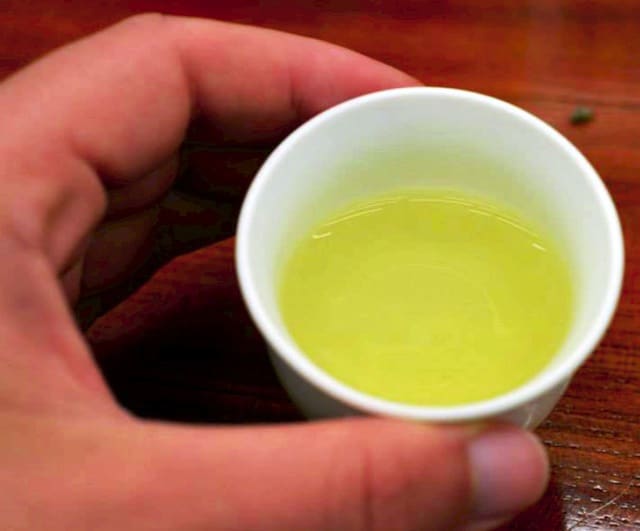
“To me this tea is very feminine,” says Katie. “It’s very soft, gentle and fragrant.”
For the second tea tasting, we sample Lishan Mountain tea, which is picked at 2,600 meters (8,530 feet) or more. Katie repeats the entire tea making ritual again, and it’s no less impressive. When she places the cylinder and cup in front of me, I gently lift it up, enjoying watching the tea empty from its container. This tea also tastes of flowers, although I feel like this one has a bolder flavor with more earthy accents, which is why Katie considers this a more masculine tea.
After sampling both teas, one thing I immediately notice is the floral flavors linger in my throat. This is due to Oolongs production process — which is much more complicated than other teas — that includes fermenting, roasting, rolling and curling the leaves. And because of their high quality, the same leaves can be brewed six to seven times to create a fragrant and flavorful tea.
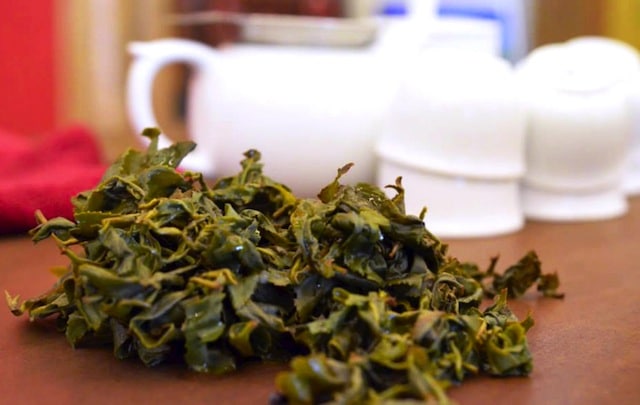
Because of the premium quality of these teas you can expect a natural and pleasant flavor — as well as a high price. High Mountain Oolongs can cost up to $500 per 500 grams if you’re purchasing Dayulin Oolong, although this is one of the priciest choices as certain high mountains producing less expensive teas than others.
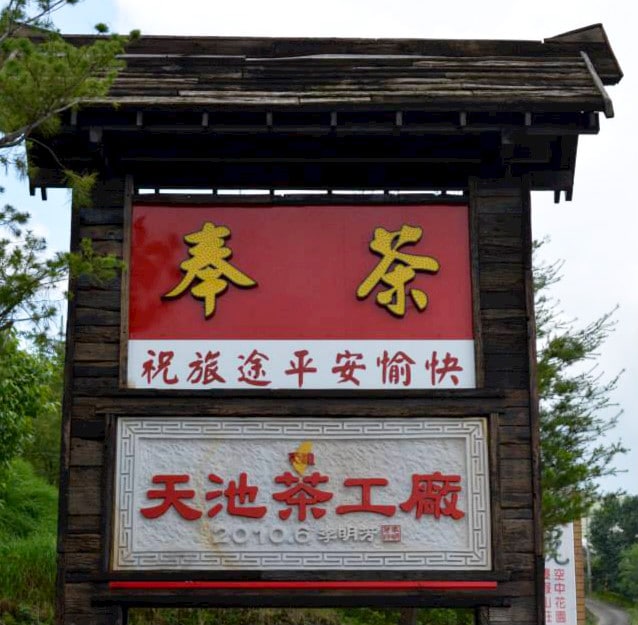
That being said, purchasing High Mountain Teas from Fungcha Tea Store in Nantou County will allow you to get a big discount from what you would pay in Taipei. Affordable prices, authentic culture, delicious complimentary tea tastings and a beautiful high mountain setting are all reasons I would recommend a stop to visit Katie and the other warm and welcoming tea shop locals in Nanto County, Taiwan.

Jessica Festa is the editor of the travel sites Jessie on a Journey (http://jessieonajourney.com) and Epicure & Culture (http://epicureandculture.com). Along with blogging at We Blog The World, her byline has appeared in publications like Huffington Post, Gadling, Fodor’s, Travel + Escape, Matador, Viator, The Culture-Ist and many others. After getting her BA/MA in Communication from the State University of New York at Albany, she realized she wasn’t really to stop backpacking and made travel her full time job. Some of her most memorable experiences include studying abroad in Sydney, teaching English in Thailand, doing orphanage work in Ghana, hiking her way through South America and traveling solo through Europe. She has a passion for backpacking, adventure, hiking, wine and getting off the beaten path.








